Lens have been an example to clubs all around the world for the past few seasons in how to effectively rebuild and regularly compete above their means with a sound strategy and stability around the club, featuring a healthy dose of intelligent people in decision-making positions.
Last October, their stable structure was threatened as sporting director Florent Ghisolfi was tempted away from Stade Bollaert-Delelis and given the sporting director position at INEOS-owned Nice. His chief scout, Grégory Thil, was also expected to be on his way to the Allianz Riviera to take on a new challenge in the Alpes-Maritimes department.
However, Thil made a u-turn and ended up deciding to remain with Les Sang et Or, taking up the then-vacant technical director position, replacing his former colleague Ghisolfi in the recruitment hot seat.
This transfer window has been Thil’s first opportunity to lead his club into the summer with the keys to the recruitment kingdom well and truly in his hands — and it hasn’t been a window without its challenges, with the main tasks being to replace Seko Fofana, who departed Lens for Saudi Pro League side Al-Nassr, and finding someone who could take over the goalscoring mantle from Loïs Openda, who ended up joining Bundesliga title hopefuls RB Leipzig.
Our recruitment analysis will use a combination of data, tactical analysis and visual scouting to assess Lens’ approach to the 2023/24 summer transfer window, particularly focusing on the two challenges of replacing Openda and replacing Fofana to highlight their recruitment strategy in action.
Our team and recruitment-focused scout report will look at the roles departed players had in Franck Haise’s strategy and tactics, as well as why the chosen replacements stood out to the club in their bid to keep their squad strong enough to compete at the business end of Ligue 1 while balancing the challenge of UEFA Champions League, which they’ll face this term.
Recruitment history
Firstly, let’s take a look back at how Ghisolfi helped fuel Lens’ rise from Ligue 2 to the UEFA Champions League spots via intelligent recruitment from his start in the sporting director position back in the summer of 2019, at which point the club was embarking on its fifth-straight second-tier season, up until last summer — his final transfer window at the Pas-de-Calais-based side.
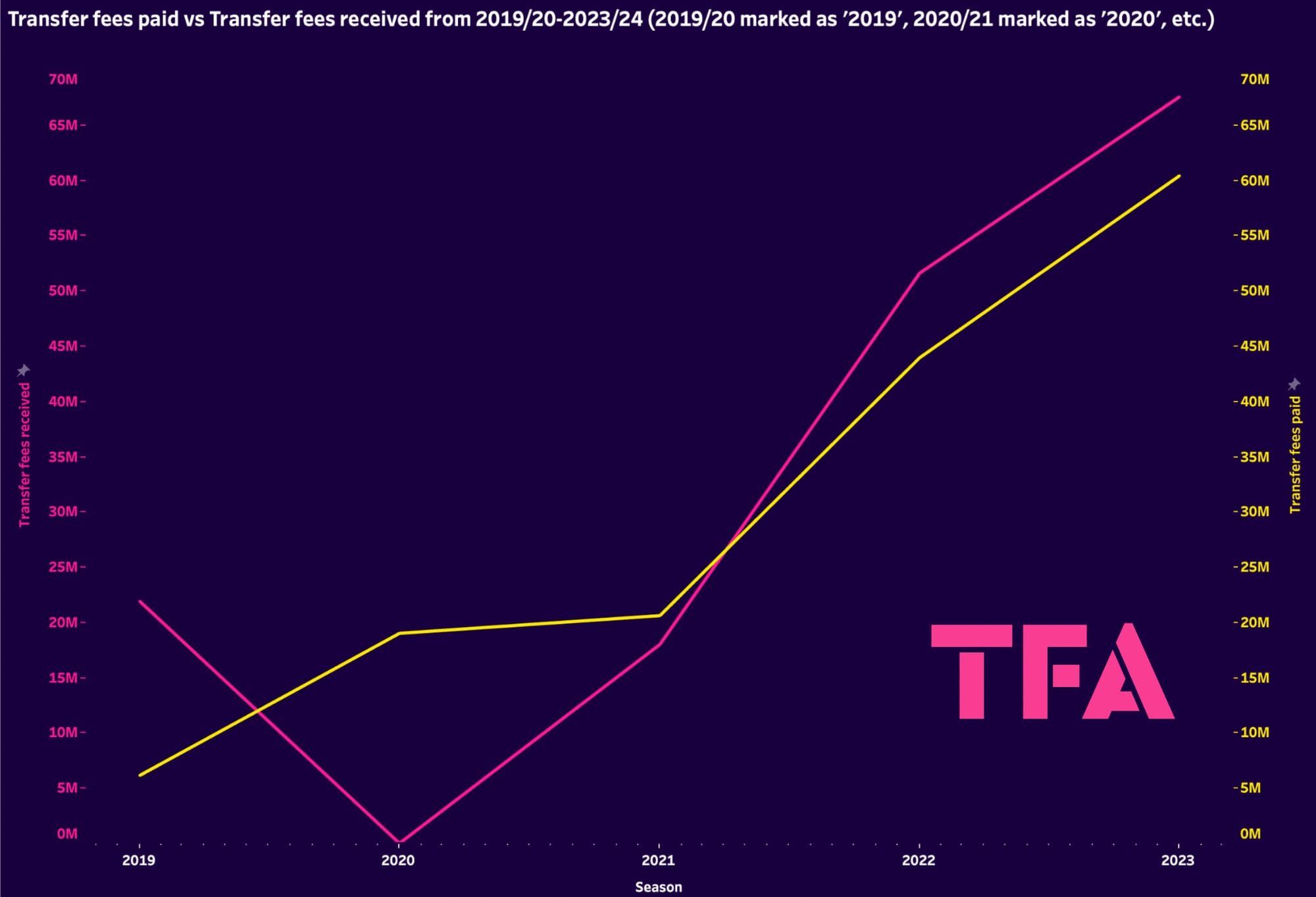
From this visual, we can see how Lens’ transfer dealings crept up, little by little, over the years, leaving them in a position to spend just over €60m this summer while still making an overall transfer profit thanks to their sales of Openda, Fofana and Jean Onana which reportedly totalled just over €67.5m.
This has partly been helped by their good league positions over the years — after finishing second and gaining promotion from Ligue 2 in 2019/20, they would finish seventh, seventh and second in the top-flight in the three subsequent seasons, undoubtedly leading to a nice budget boost compared to when they were stranded in the second-tier.
However, their ability to flip players for a profit and adequately replace them at a lower price has also played a big part in this. Openda provides one great example of this; he was signed last summer for just over €15m but then sold for more than twice that figure this summer after a great Ligue 1 campaign — the value of showcasing a player on the ‘top-five league’ platform as Lens can.
Les Sang et Or have notably managed to do this with the likes of Fofana (signed for €8.5m in 2020, sold for €25m this summer), Christopher Wooh (signed for free in 2021, sold for €9m in 2022), Jonathan Clauss (signed for free in 2020, sold for €7.5m in 2022) and Loïc Badé (signed for free in 2020, sold for €17m in 2021) over the years, highlighting a consistent ability to increase players’ value and reputation rapidly at Stade Bollaert-Delelis.
Intelligent recruitment helps this, as does a certain level of consistency in the approach (helped by having had Ghisolfi in charge for all those years before being replaced by Thil from his team — someone who knows very well how Ghisolfi worked and how he helped Lens climb to such heights in his time as sporting director).
Consistency is a very useful word to describe the reasons for Lens’ success in recent years, however, with the club also having had coach Haise in the manager’s seat since their promotion-winning campaign and utilising either a 3-4-1-2 or 3-4-2-1 throughout this time.
This leads to Lens recruiting players for very specific roles, helping them find good fits for Haise and their system while, at the same time, being aware of the profiles within their squad and focusing primarily on finding different profiles to ones they already have, ensuring each player adds a uniqueness to the overall setup, all the while recruiting with a clear idea of the system these players will be brought into and their suitability to that.
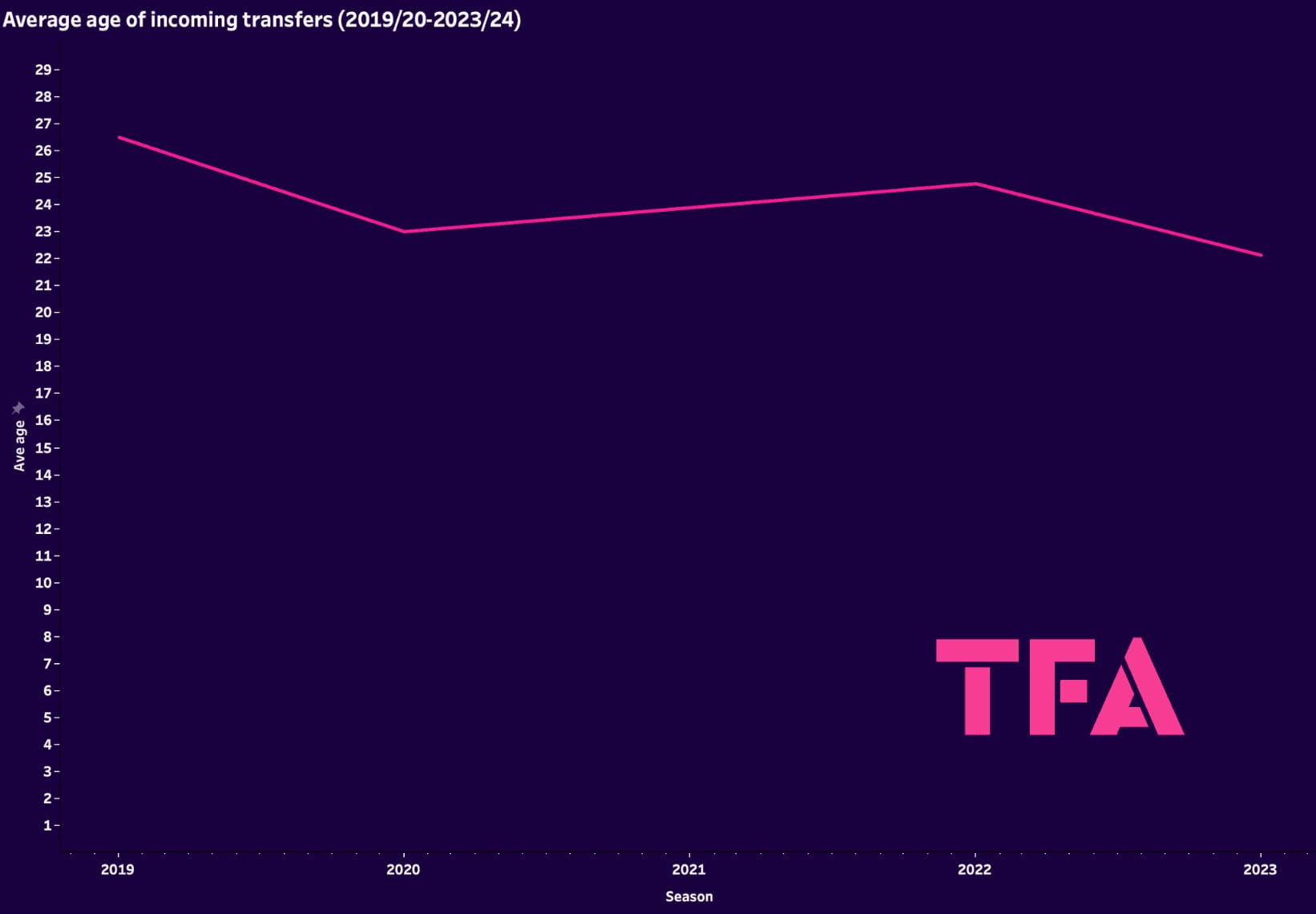
In terms of age profile, Lens’ signings have generally had an average age of around 24 per season over the last few campaigns, dropping from 26.5 in 2019/20. This season so far, their signings have an average age of 22.125, representing a sharp enough drop — whether that proves to be an outlier in the long-term or a further trend with Thil as technical director remains to be seen, but an interesting observation from this summer nonetheless.
Replacing Openda
As mentioned, replacing Loïs Openda has been one of Lens’ biggest challenges this summer, and thus one of Thil’s biggest challenges in his first summer as the club’s technical director.
The Belgian forward scored 21 league goals and provided four league assists last season, playing a major part in Lens’ successful attempt to push PSG all the way in the Ligue 1 title race, ultimately finishing just one point off Les Parisiens.
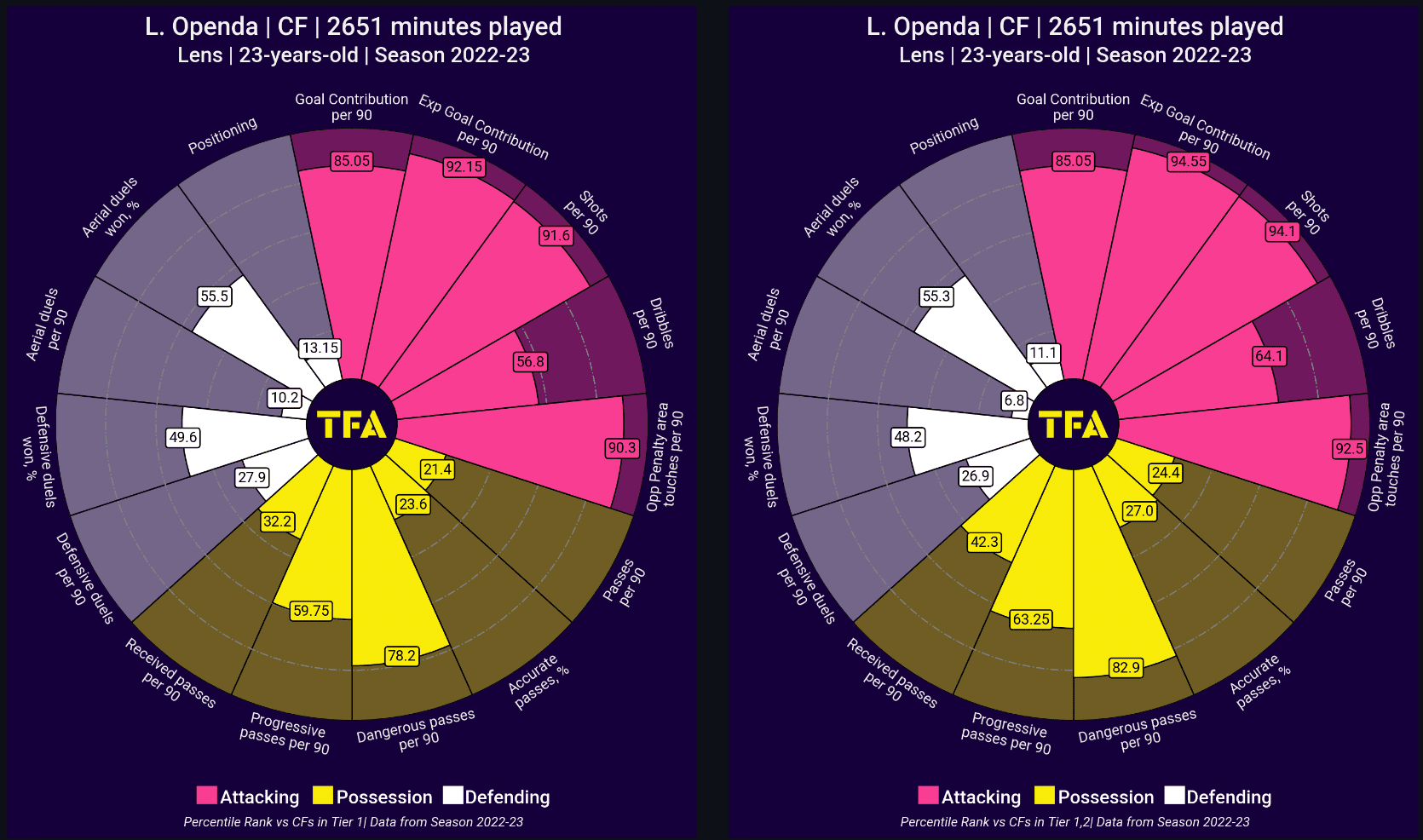
Here, we can see the forward’s 2022/23 performance put into perspective when compared with his peers. Openda clearly stands out in a big way from a goal contribution and expected goal contribution standpoint. He’s a high-volume shooter who’s also quite liable to put one on a plate for a teammate, highlighting his multifaceted threat.
It’s common to find Openda roaming around the width of the forward line, generally spending most of his time in the centre-forward position but having been utilised in quite a fluid front-three with Lens last season, demonstrating his quality in wider areas frequently. Furthermore, it’s common to see him drop off and receive in slightly deeper areas before driving at the opposition’s defence, taking the opportunity to show off his dribbling quality.
As mentioned earlier, he was sold for just under €40m before being replaced by Sepe Elye Wahi — a promising 20-year-old forward we wrote a scout report on here at Total Football Analysis last summer, if you fancy getting an in-depth rundown on the new Lens talent — who joins Les Sang et Or from Ligue 1 rivals Montpellier for €30m.
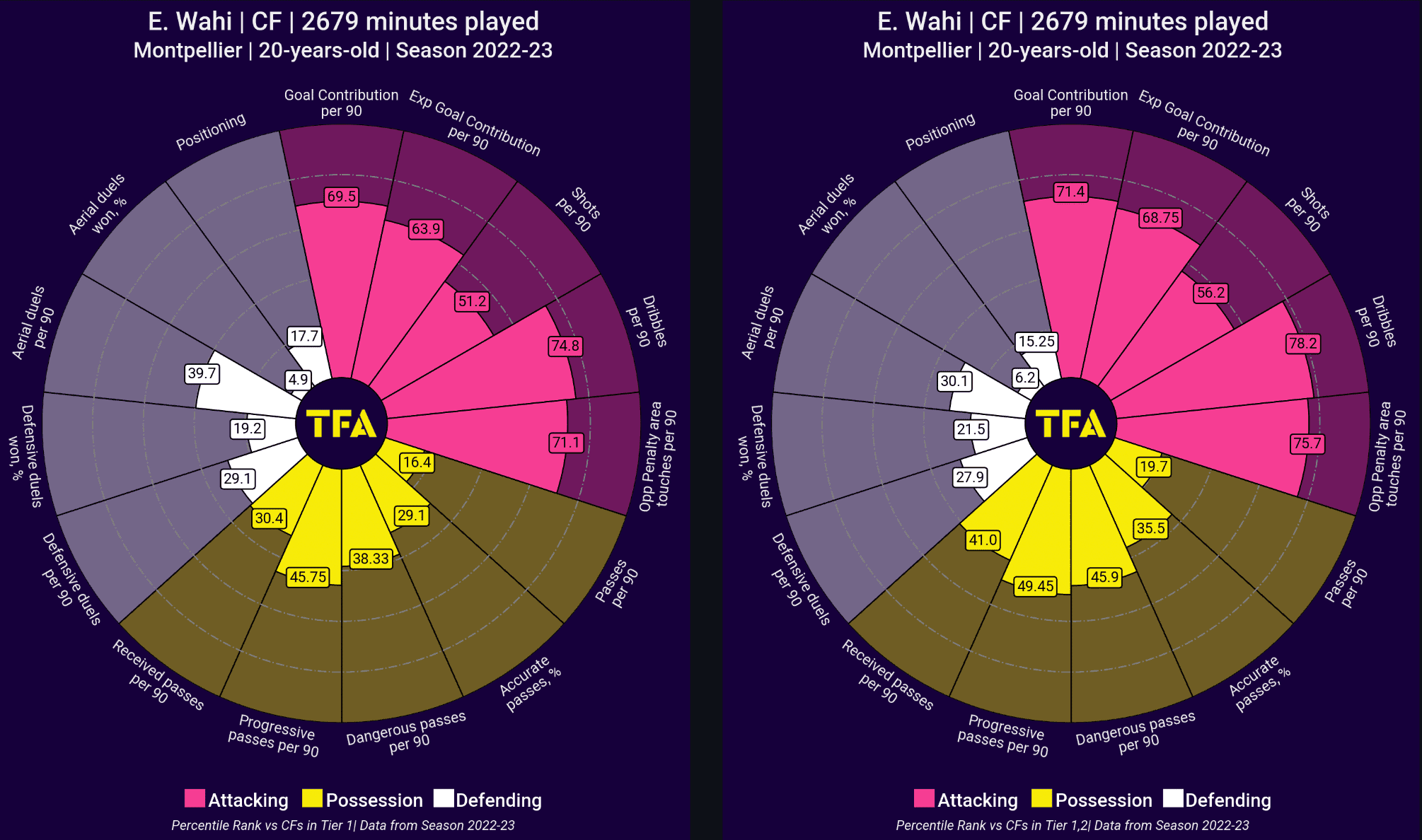
Though not putting up the same outstanding numbers as Openda last season, we can see that Wahi also stands out in terms of his goal contribution and expected goal contribution, with dribbling actually having been an even more prominent part of the France U21 international’s role with Montpellier than Openda’s with Lens.
What Lens will lack more at centre-forward with Wahi compared to Openda is the chance creation. Don’t expect the new signing to set up teammates as much as Openda did or drop off to receive the ball to feet as often as his predecessor in the Lens centre-forward spot — he won’t do that and link-up play remains an area of improvement for the former Montpellier man in this regard.
Wahi’s game sees him sitting on the defenders’ shoulders and threatening to be played in behind either through the centre or out in wider areas, with the 20-year-old comfortable in these positions just as Openda was; his dribbling quality and excellent finishing ability help him to pose a significant threat from all around the final third.
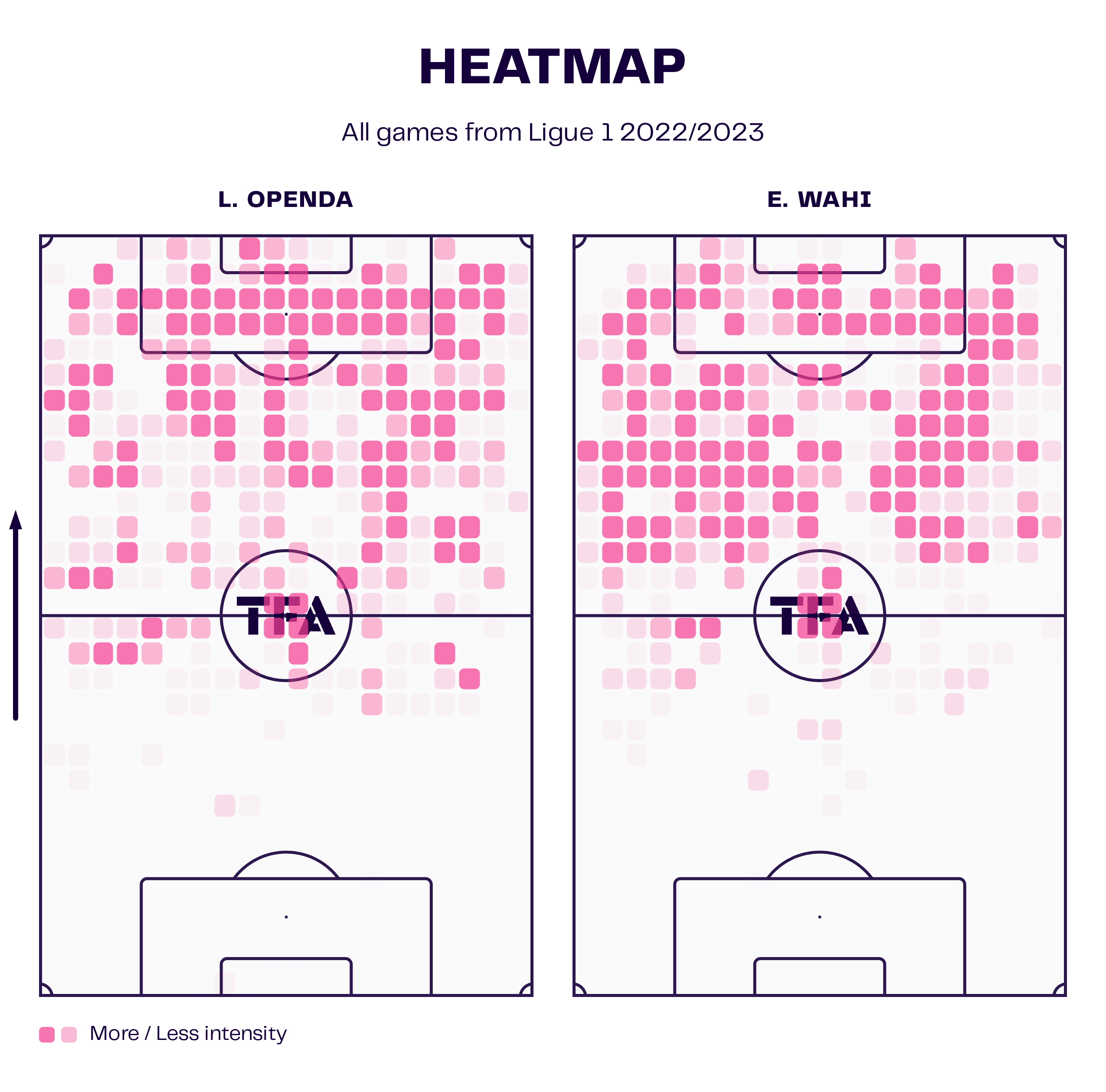
If you watch Wahi play, you’ll see some similar characteristics to Openda, including that tendency to drift out into wider areas and not just stay centrally. This will help him slot right into Lens’ fluid attack in place of the departed Openda.
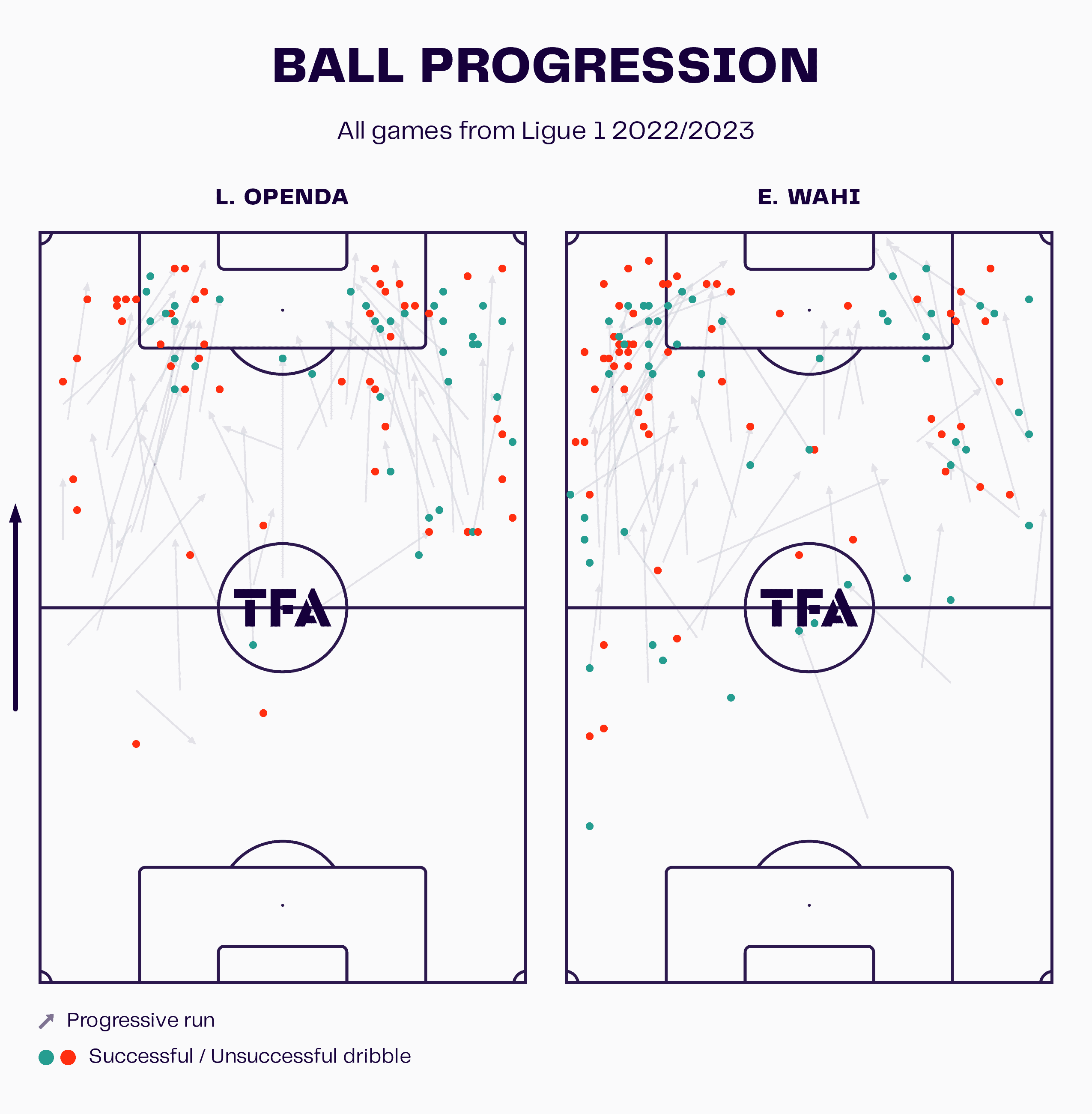
This comparison of the two attackers’ respective ball progression maps from 2022/23 further displays their habit of drifting out wide to receive before looking to beat a defender and carry the ball into a more valuable and threatening position inside the danger zone.
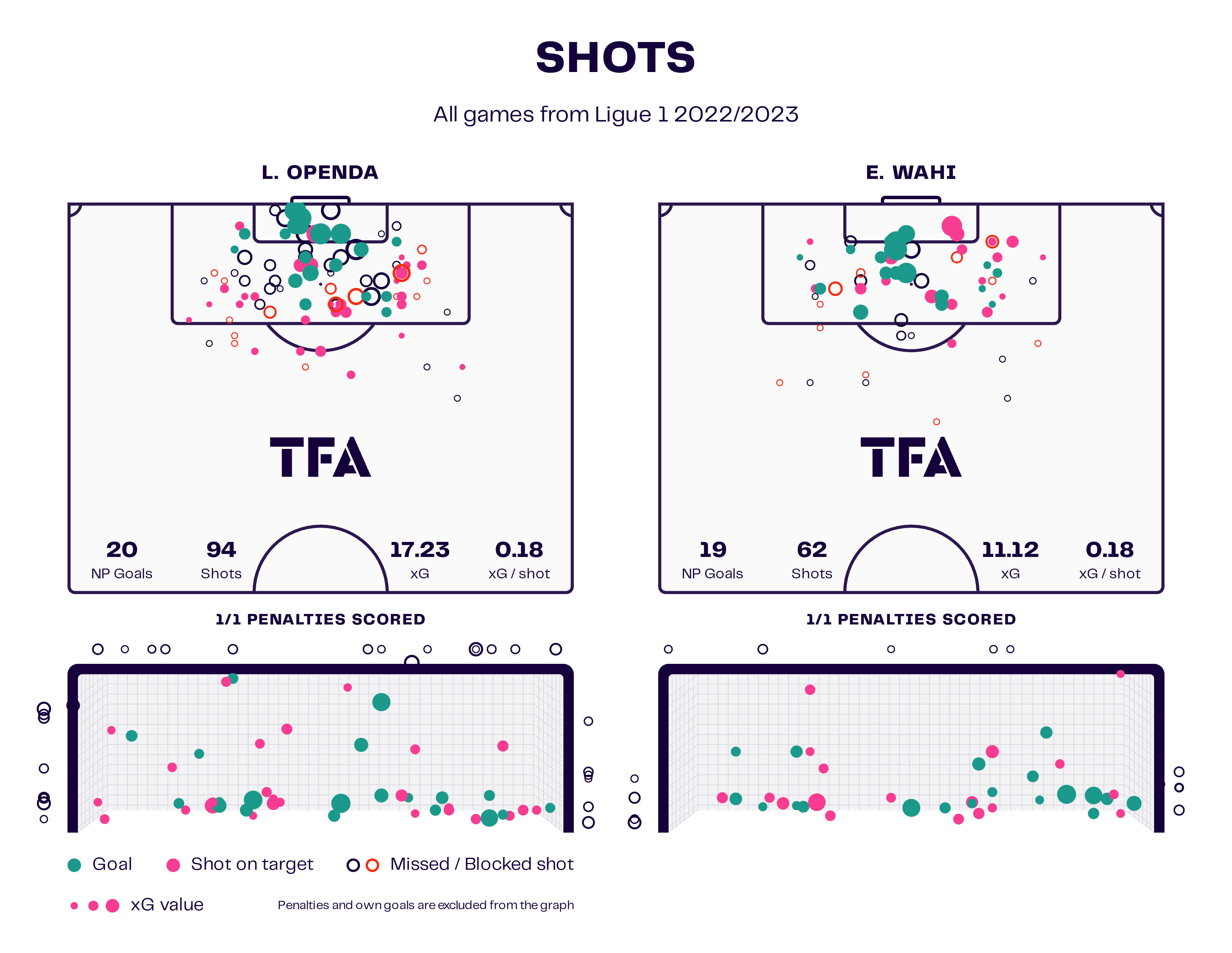
Wahi has always demonstrated wonderful off-the-ball movement, positioning and shot selection — helping him to give his teammates a good option inside the box and generate a lot of high-quality chances.
Despite playing for a lower scoring Montpellier side last season, he ended up netting just one less league goal than Openda last term. The pair had a matching xG per shot of 0.18 — a very respectable count for that particular statistic.
While Wahi ended up taking about two-thirds of the shots Openda took in 2022/23, we can expect that to change this term as he joins a Lens side with more attacking quality and capability of creating plenty of chances for the centre-forward.
Replacing Fofana
Lens’ other major challenge this summer was replacing Seko Fofana, who had become a vital part of Haise’s side over the past few seasons — ultimately captaining the side to their second-place finish of 2022/23.
In order to understand how to replace Fofana, we first need to discuss his role within Haise’s system.
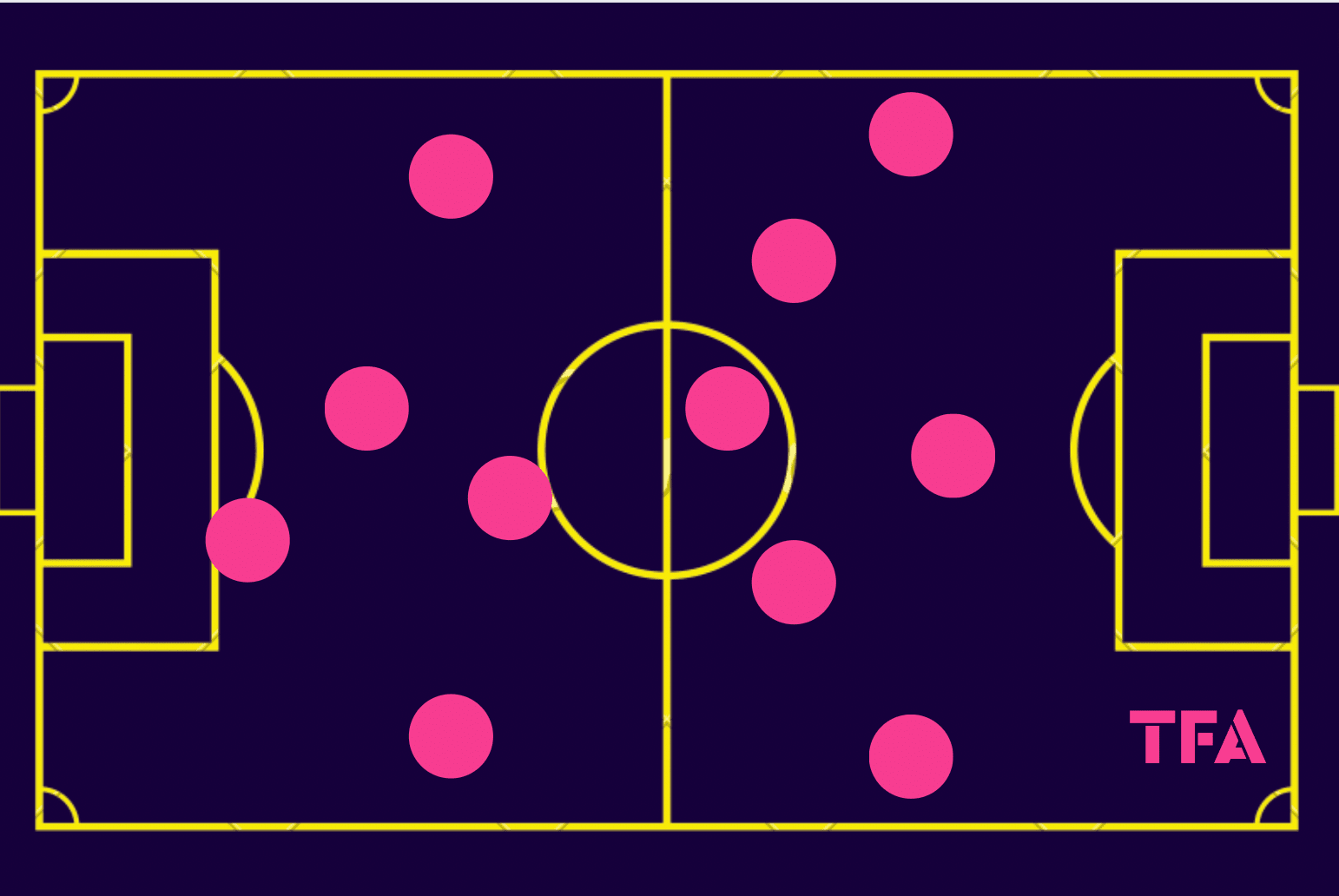
This image provides us with a typical example of Lens in the progression phase. Their centre-backs would generally split very wide while the central midfield duo, typically Fofana and Salis Abdul Samed last season, would stagger with one remaining deep in front of the backline and one advancing to become sort of a central ‘10’.
Fofana’s role was that of the more advanced midfielder positioned in between the left and right attacking midfielders in figure 8.
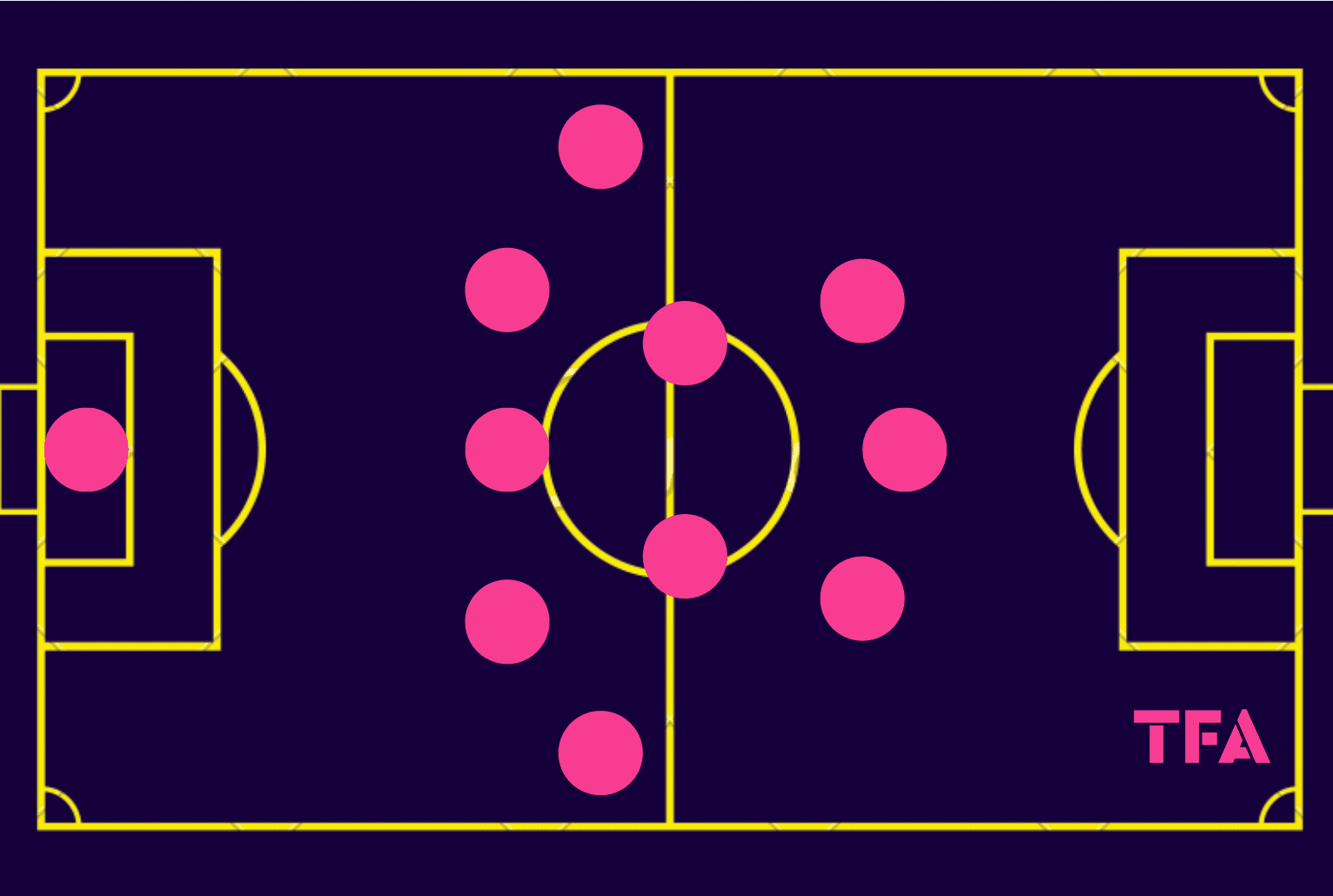
Out of possession, he’d tuck back in alongside Samed and behind the front three, with the wing-backs shifting back to sit just outside the midfielders and defenders. Lens’ press would vary in intensity depending on the opposition, but Fofana was frequently required to defend on the front foot and support the forwards as they forced the opposition out wide and subsequently pressed them aggressively in wider areas.
This would leave space for the central midfielders to cover in order to prevent the opposition from playing through them in valuable central areas.
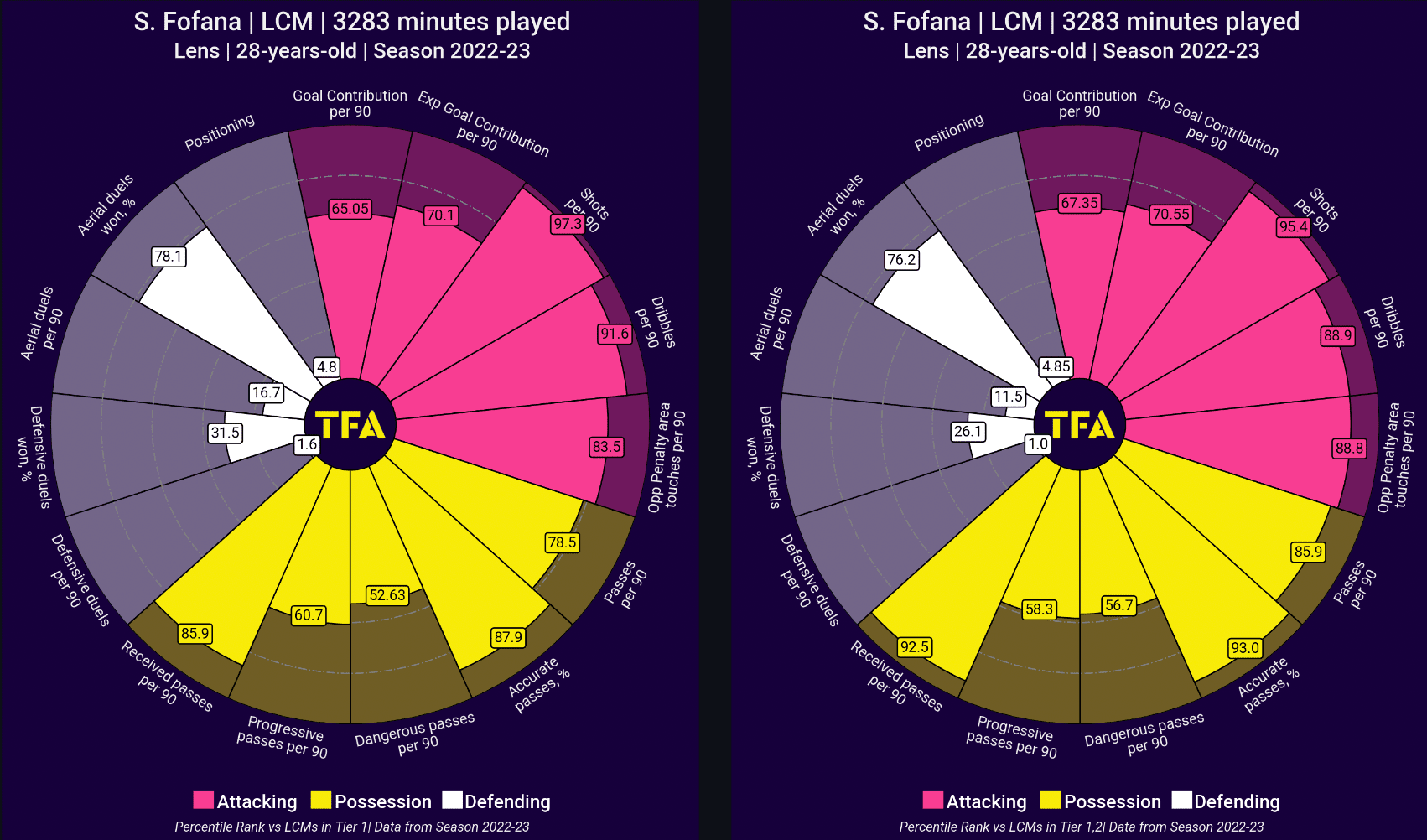
Fofana’s in-possession contribution was the primary positive to his game. He would frequently receive in high positions and link up with teammates there, helping his side progress into the final third via his movement and passing play.
This is without mentioning his dribbling, with Fofana representing another Lens player with excellent ball-carrying ability to help his side push beyond defenders and advance into more valuable goalscoring positions.
Lastly, Fofana was another high-volume shooter who loved to try and get himself into good goalscoring positions for his side, frequently arriving into the box with late runs and carrying the ball beyond defenders before trying his luck once some space had been generated.
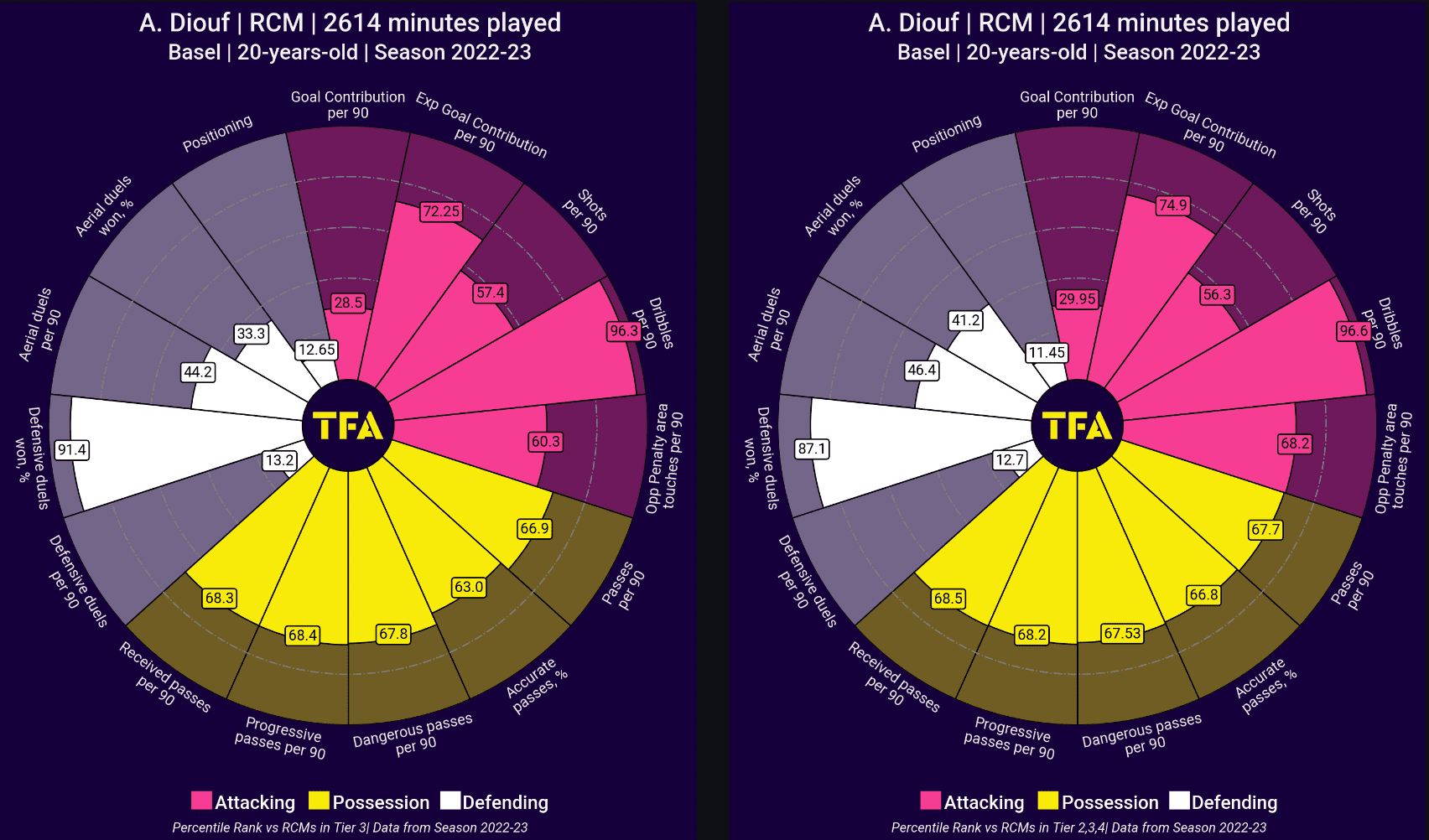
As for his apparent replacement, Andy Diouf who was signed for a reported €14m from FC Basel — €11m less than Lens received for Fofana from Al Nassr — he shares plenty of similarities with Fofana in that he’s a central midfielder who likes to be positioned higher upfield, frequently aiming to drive at defenders and carry it past them with his dribbling quality.
The 20-year-old had a high expected goal contribution percentile rank in 2022/23, though he shoots far less than Fofana and this is a major difference between the two; while Fofana is a high-volume shooter, Diouf is not so much, with a higher portion of his expected goal contributions coming from his attempted shot assists.
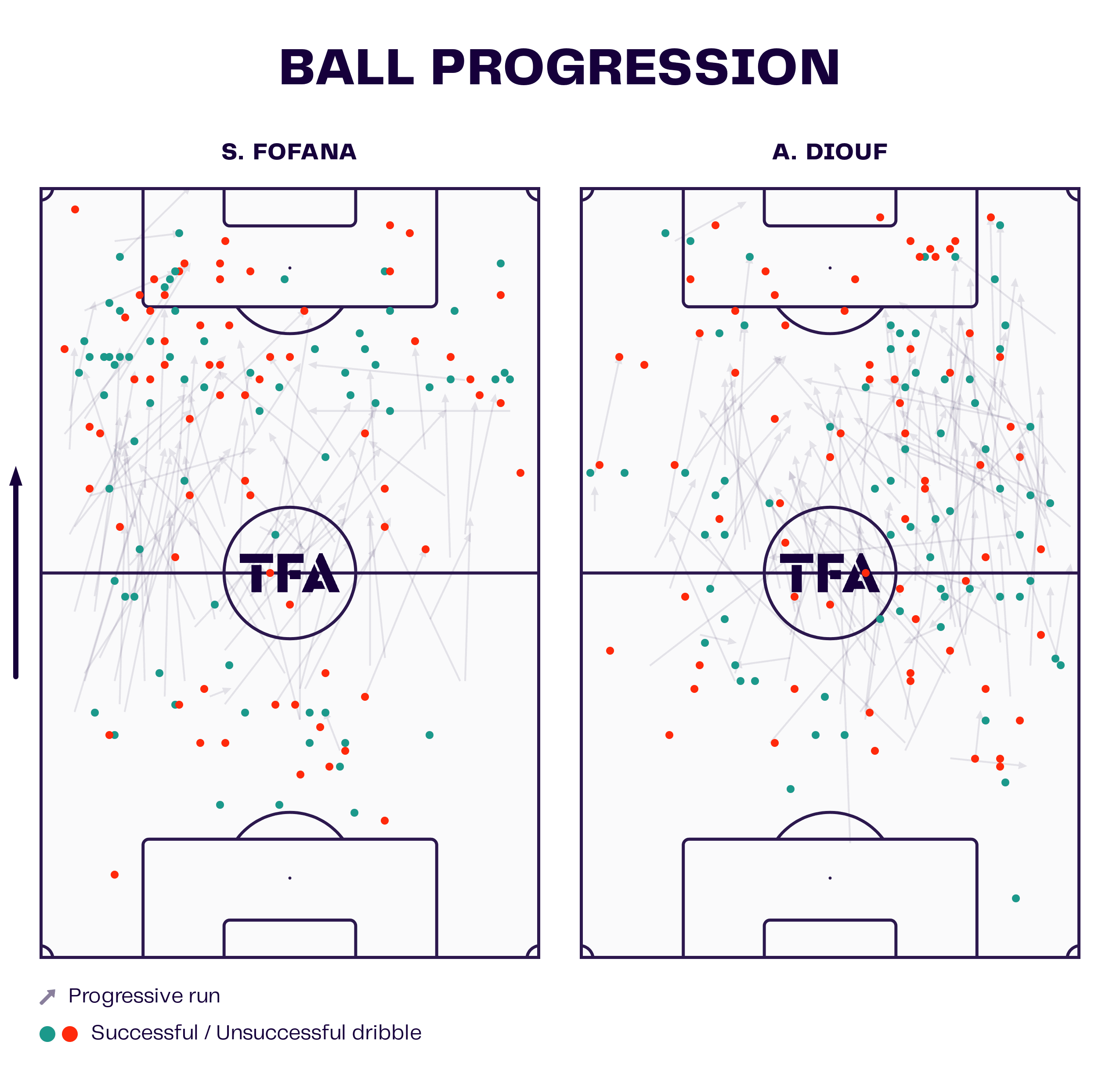
Figure 12 demonstrates how these two midfielders both like getting on the ball and driving at defenders in advanced areas — we can expect Diouf to slowly but surely settle into that advanced central midfielder role that Fofana played at Lens, receiving in between the wide attacking midfielders in the progression phase and facilitating progression into the final third for his side.
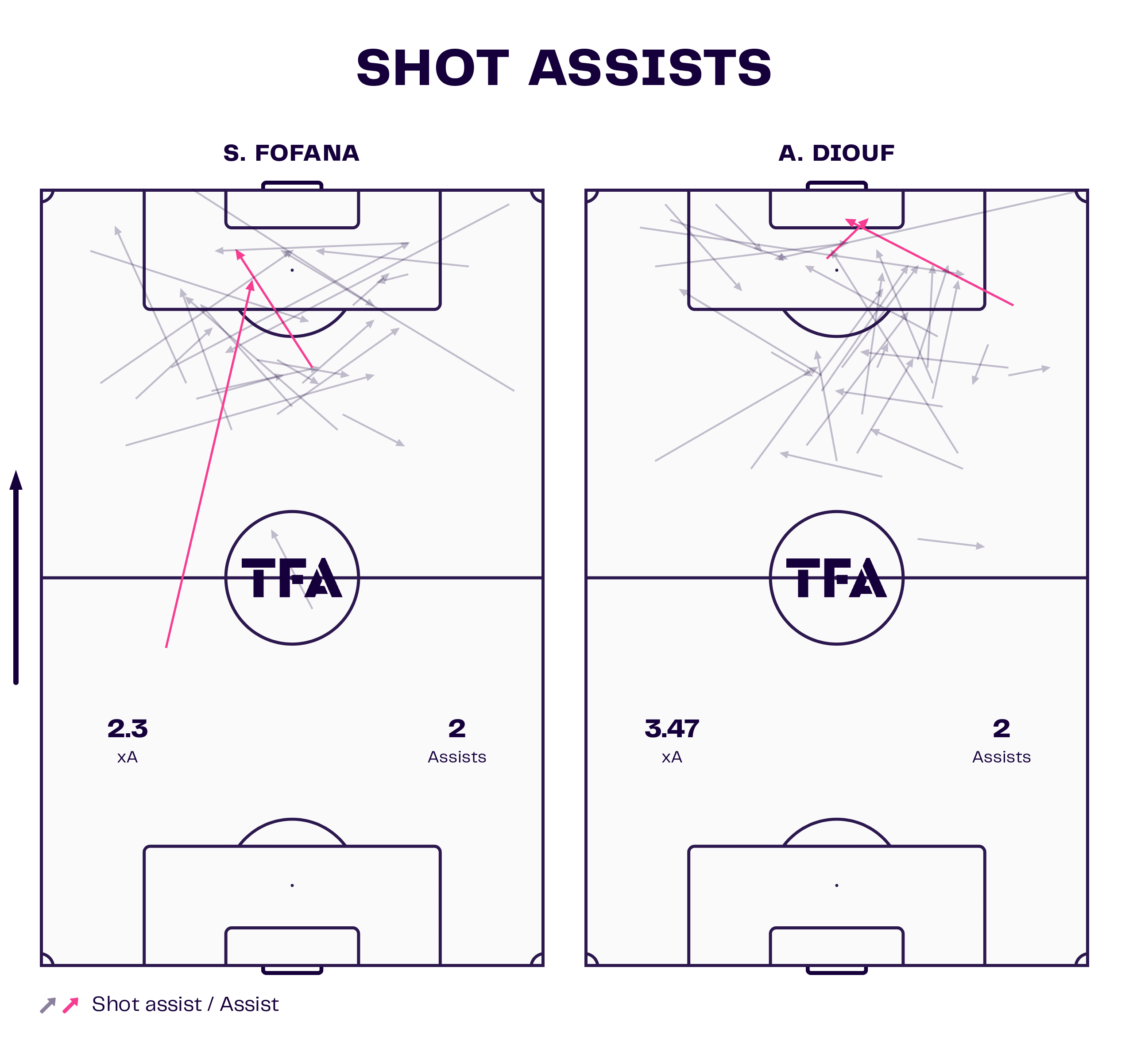
Figure 13, then, displays the two midfielders’ respective shot assist maps from 2022/23, with Diouf generating over one expected assist more than Fofana in the Swiss Super League compared to the now-ex-Lens man in Ligue 1.
Both midfielders love to spring passes in behind the defensive line from the edge of the final third, which the likes of Wahi will grow to love once they get familiar and settled as teammates.
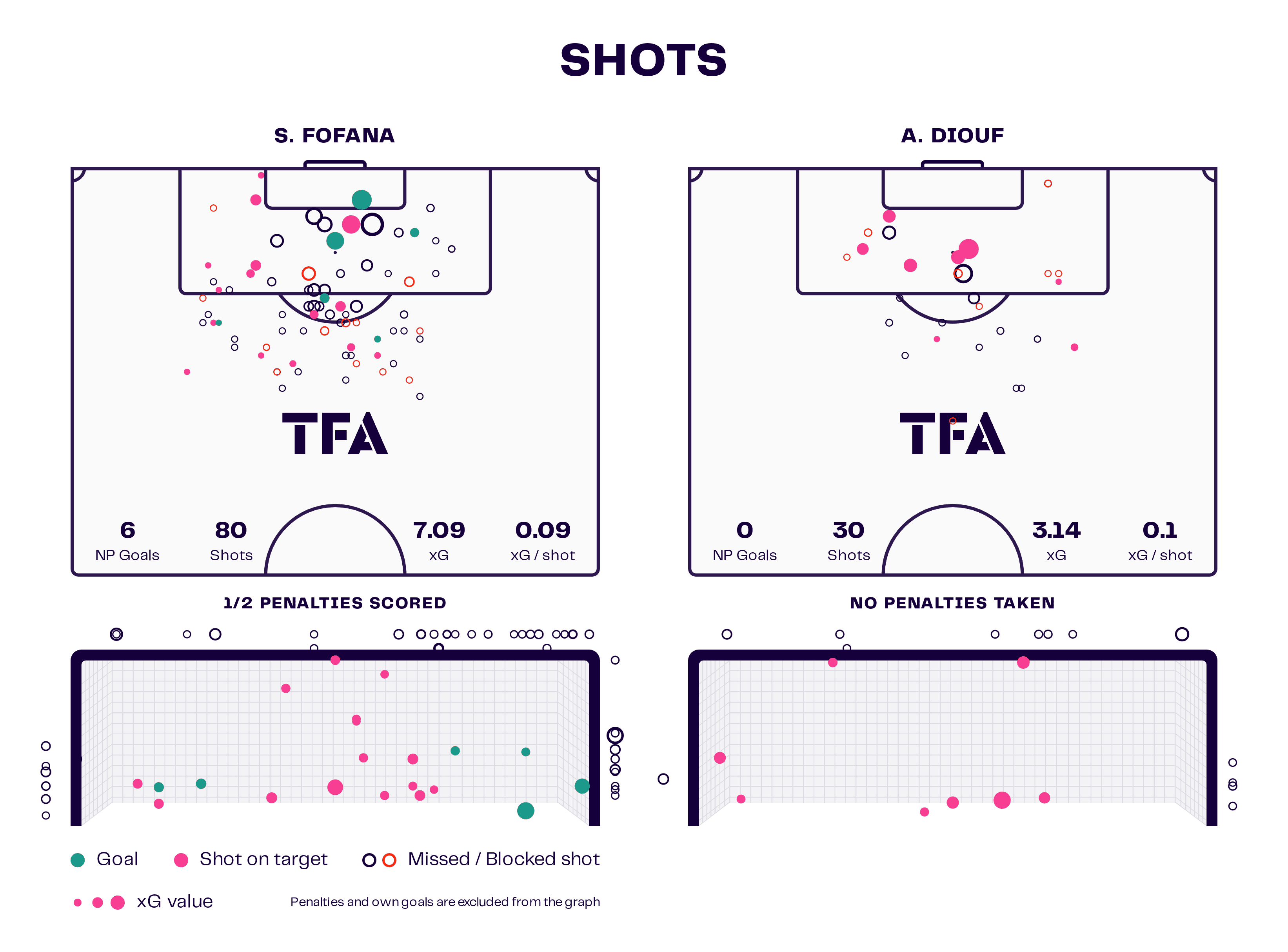
While Diouf doesn’t take quite as many shots as Fofana, he does still generate a decent level of direct goal threat, with the ex-Basel man ending 2022/23 with 3.14 xG, though he failed to actually convert any of his 30 shots.
Perhaps this is something that will change over time, but we’d definitely expect Diouf to prioritise chance creation over chance conversion to a greater extent than Fofana did. Still, the new Lens man has shown he can pop up in good goalscoring positions and offer a threat for his team in that regard, as the above shot map indicates.
Conclusion
To conclude this recruitment analysis and scout report, we hope it’s clearer how Lens have opted to replace their two key departures this summer and why the respective replacements — Wahi for Openda and Diouf for Fofana — were the chosen ones.
Both new signings have previously shown the necessary qualities to fulfil the required roles of the two departures within Haise’s Lens system while offering slightly different specific profiles.
Both are younger as well, representing an opportunity for Lens to once again give players a platform to shine before moving them on elsewhere, generating a transfer profit and an opportunity to reinvest at an even higher level than before, continuously building up the strength of their squad in a sustainable manner, as has been their recruitment model for the last few years.
Of course, these aren’t the only interesting signings Lens have made this summer, with Stijn Spierings (free), Angelo Fulgini (€7.2m), Óscar Cortés (€4.5m), Morgan Guilavogui (€4m), Neil El Aynaoui (€600k) and Abdukodir Khusanov (€100k) all joining to become squad members who Lens will hope to build up and propel to greater recognition in the future.
However, the signings we’ve focused on here give us clear examples of Les Sang et Or’s recruitment model and methods of replacing key departures with promising talents for whom they have a clear plan and vision, which is a major part of what’s led them from Ligue 2 to the UEFA Champions League in five seasons.





Comments